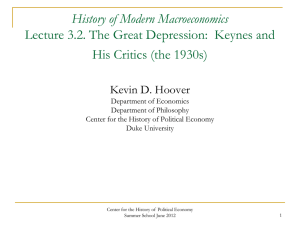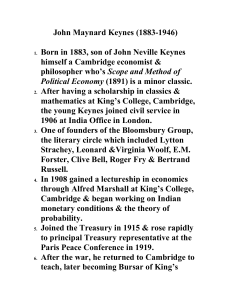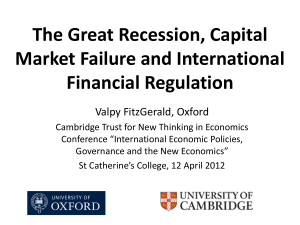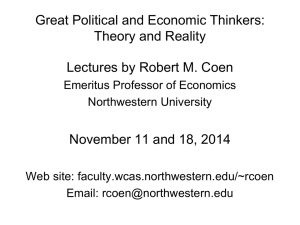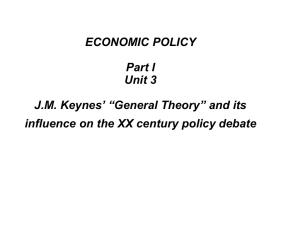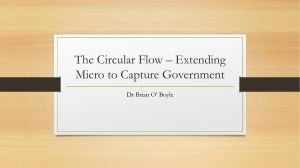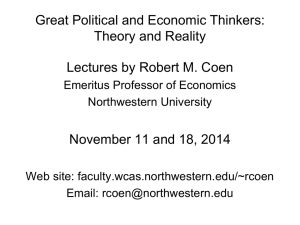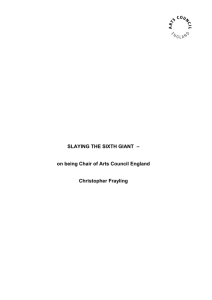classical gold standard
advertisement
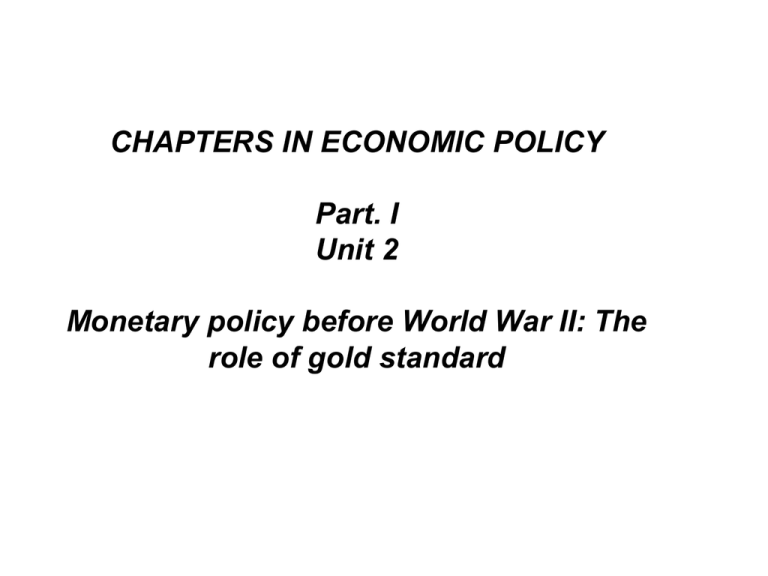
CHAPTERS IN ECONOMIC POLICY Part. I Unit 2 Monetary policy before World War II: The role of gold standard The classical gold standard was characterized by the following principles: • interconvertibility between domestic money and gold at a fixed official price • freedom for private citizens to import and export gold • a set of rules relating the quantity of money in circulation in a country to that country’s stock of gold Provided that: - each country adhering to the gold standard is willing to convert its domestic currency into a fixed weight of gold; - the price of gold is set on the world markets subject only to the margins covering shipping and insurance cost (“law of one price”) an international gold standard establishes fixed exchange rates between national currencies At least in principle: - balance of payments settlement are effected through international tranfer of gold; - balance of payments equilibrium is obtained through the impact of gold flows on internal economic conditions - The gold standard has been frequently interpreted and presented as a self-equilibrating system - As a consequence of this alleged property, it was advocated during the XX century by several liberal economists, who advocated policies based on rules rather than discretion (M. Friedman, L. von Mises, F. Hayek) - The first example of a formal model of the gold standard as a self-equilibrating system was actually David Hume’s price-specie flow mechanism (Political Discourses, 1752) - Hume’s implicit assumption: flexibility (in particular, downward flexibility) of prices and nominal wages - In Hume’s analysis there is no mention of the role of banks, either private banks or the Central bank • i) ii) Hume’s analysis highlights the close connection between: gold movements and money supply the supply of currency and the price level The price-specie flow mechanism emphasizes the impact of price movements on the balance of trade In the XVIII century, in the international transactions trade in goods was definitely more important than capital flows - During the XIX century the textbook treatments of the classical gold standard included the banking system, but portrayed central banks as obeying “rules of the game” • According to these “rules”, monetary authorities had to intervene in order to reinforce the impact of gold flows on domestic money and credit and to speed up the equilibrating mechanism -E.g.: if a Central bank was losing gold as a consequence of a current account (net export) deficit, monetary authorities had to raise the discount rate - This measure caused: i) an increase of the cost to the banking sector of rediscounting at the Central bank. This determined a reduction in aggregate demand and production (Y). As a consequence, Import decreased; ii) an inflow of capital from abroad (the current account deficit is compensated in the short run by a capital account surplus) • The actual working of the gold standard was however quite different from these stylized accounts: 1) far from being the normal state of affairs prior to the XX century, the gold standard prevailed on a global scale for scarcely a third of century (from 1880 to 1914). At the beginning of the XIX century, domestic currencies were based on silver rather than on gold - Britain was an exception having been on a de facto gold standard from 1717 and on a full legal gold standard from 1821 (as a result of the so called resumption act) - Gold standard was adopted at an international level only from the beginning of the 1870s: Germany adhered to this system in 1871; United States in 1879 • 2) Convertibility of banknotes issued by central banks was indeed a powerful check against hyperinflation in that it ruled out debt monetization • Debt monetization: is the process by which the government issues bonds and forces the Central bank to buy them; the central bank pays the government bonds with the money it creates, and the government uses that money to finance the deficit • However: a) convertibility was actually guaranteed only in a few countries (the “core” of the system: Britain, US, Germany). In other countries (France, Belgium, Italy) convertibility was at the authority option; b) since the relative price of gold in terms of goods and services is far from fixed, in the medium and long run domestic price stability was far from granted (e.g. during the 1880s most European countries experienced substantial deflation); 3) the gold standard was on the whole an asymmetric and deflationary biased system: countries running a current account deficit (NX0) were forced to adopt restrictionary monetary policies and to accept higher unemployment in the short run, in order to reduce domestic prices and nominal wages and therefore to improve their ability to compete internationally on the contrary, countries running a current account surplus could simply “sterilize” the inflow of gold and were by no means forced to adopt expansionary monetary policies 4) far from working automatically, the classical gold standard was to certain extent a managed system, in that it was managed by the Bank of England. - London was the most important financial centre of the time and this pre-eminence provided the Bank of England with significant leverage over international flows of capital and gold - -Monetary policies were harmonized internationally through a leader-follower interaction: when the bank rate was raised in London, central banks in continental Europe had no choice but to adopt restrictionary policies (similarities with the European Monetary System in the 1980-90s) - With the outbreak of World War I, convertibility was suspended either de facto or de jure by all European countries - In the belligerent countries debt monetization became the rule. This brought high and persistent inflation - After the war, as a consequence of high inflation, the return to pre-war parities became infeasible. Gold standard was suspended and nominal exchange rates were let to float (the only exception being the United States) - Widespread agreement among economists after WWIthat returning to gold was in itself a desirable goal - In UK this topic was analysed by an influential board set by the government (the Cunliffe Committee) - In 1918 the Cunliffe Committee issued a Report (the First Interim Report) according to which re-establishing the prewar parity was not merely a desirable goal but an essential measure to ensure financial stability - The Committee’s report provided also a classic, albeit idealized, description of the working of the pre-WWI working of the gold standard: “When the exchanges were favourable, gold flowed freely into this country and an increase of legal tender money accompanied the development of trade. When the balance of trade was unfavourable and the exchanges were adverse, it became profitable to export gold. The would-be exporter bought his gold from the Bank of England and paid for it by a cheque on his account. The Bank obtained the gold from the Issue Department in exchange for notes taken out of its banking reserve, with the result that its liabilities to depositors and its banking reserve were reduced by an equal amount, and the ratio of reserve to liabilities consequently fell. [CONT.] “If the process was repeated sufficiently often to reduce the ratio in a degree considered dangerous, the Bank raised its rate of discount. The raising of the discount rate had the immediate effect of retaining money here which would otherwise have been remitted abroad and of attracting remittances from abroad to take advantage of the higher rate, thus checking the outflow of gold and even reversing the stream” - If the adverse condition of the exchanges was due not merely to “seasonal fluctuations”, but to “structural” circumstances the previous procedure was not sufficient • However, following the raising of the Bank’s discount rate, • “new enterprises were postponed and the demand for constructional materials and other capital goods was lessened […] The result was a decline in general prices in the home market which, by checking imports and stimulating exports, corrected the adverse trade balance which was the primary cause of the difficulty” • In conclusion: “There was an automatic machinery by which the volume of purchasing power in this country was continuously adjusted to world prices of commodities in general. Domestic prices were automatically regulated so as to prevent excessive imports; and the creation of banking credit was so controlled that banking could be safely permitted a freedom from state interference which would not have been possible under a less rigid currency system” - The Committee’s point of view was strongly criticized by J.M. Keynes. - In his Tract on Monetary Reform (1923) Keynes: i) observed that the re-establishment of the prewar parity of the pound implied a severe deflationary process in UK; ii) provided a detailed analysis of the negative macroeconomic and redistributional effects of monetary instability (and particularly of deflation) “In the first pIace, deflation is not desirable, because […] redistributes wealth in a manner injurious, at the same time, to business and to social stability. Deflation […] involves a transference of wealth from the rest of the community to the rentier class and to all holders of titles to money; just as inflation involves the opposite. In particular it involves a transference from all borrowers, that is to say from traders, manufacturers, and farmers, to lenders, from the active to the inactive” (Keynes, 1923, p. 118) • Furthermore: “The policy of gradually raising the value of a country's money […] above its present value in terms of goods […] amounts to giving notice to every merchant and every manufacturer that for some time to come his stock and his raw materials will steadily depreciate on his hands” (Keynes, 1923, p. 119) As a consequence: “It will be to the interest of everyone in business to go out of business for the time being; and of everyone who is contemplating expenditure to postpone his orders so long as he can. The wise man will be he who turns his assets into cash, withdraws from the risks and the exertions of activity, and awaits in country retirement the steady appreciation promised him in the value of his cash. A probable expectation of deflation is bad enough; a certain expectation is disastrous” (Keynes, 1923, p. 119) iii) In his Tract Keynes analysed also the trade off between internal balance (domestic price level stability) and external balance (exchange rates stability) and argued that, particularly after WWI, domestic price stability had to be considered by far the most important goal In Keynes words: “In pre-war days, when almost the whole world was on a gold standard, we had all plumped for stability of exchange as against stability of prices, and we were ready to submit to the social consequences of a change of price level for causes quite outside our control, connected, for example, with the discovery of new gold mines in foreign countries or a change of banking policy abroad. But we submitted, partly because we did not dare trust ourselves to a less automatic (though more reasoned) policy, and partly because the price fluctuations experienced were in fact moderate” (Keynes, 1923, p. 126) - Keynes admits that “prudent people should desiderate a standard of value which is independent of finance ministers and state banks” and that “the chief object of stabilising the exchanges is to strap down ministers of finance” - However, he observed, gold itself had become a 'managed' currency “The United States has not been able to let gold fall to its 'natural' value, because it could not face the resulting depreciation of its standard. It has been driven, therefore, to the costly policy of burying in the vaults of Washington [Federal Reserve] what the miners of the Rand have laboriously brought to the surface. Consequently gold now stands at an 'artificial' value, the future course of which almost entirely depends on the policy of the Federal Reserve Board of the United States” (Keynes, 1923, p. 134) • In conclusion: “The gold standard is already a barbarous relic. AlI of us, from the Governor of the Bank of England downwards, are now primarily interested in preserving the stability of business, prices, and employment, and are not likely, when the choice is forced on us, deliberately to sacrifice these to the outworn dogma, which had its value once, of £ 3, 17s, 101/2 d per ounce” (Keynes, 1923, p. 138) In 1925, however, Winston Churchill, then Britain’s Chancellor of the Exchequer, decided to return to the gold standard at the prewar parity To a large extent, the interests of the British industry were sacrificed to the interests of finance, though “there were those who hoped that US prices would rise sufficiently to relieve Britain of the burden of deflation” (Eichengreen, 1992) -However in US the Fed pursued a policy of de facto price stabilization and sterilized the inflows of gold -As predicted by Keynes, at least in the short run the outcome for UK was a severe recession, higher unemployment and social unrest

